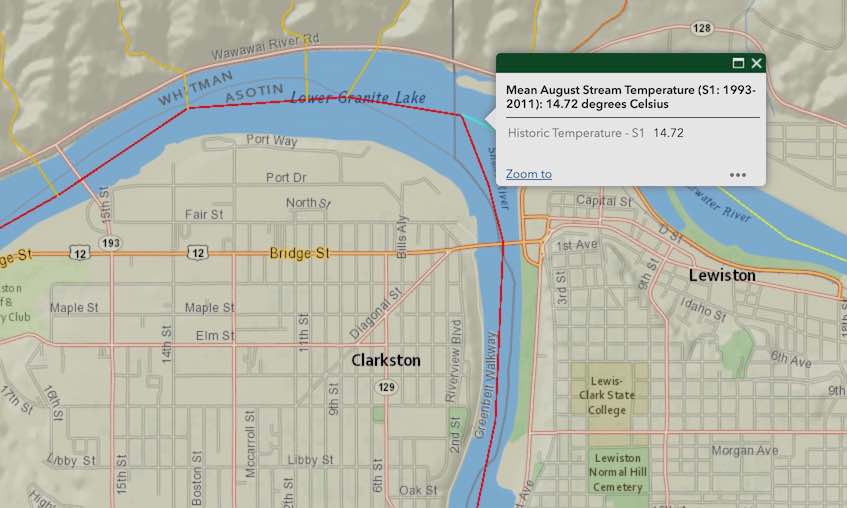forum
library
tutorial
contact

River Temperatures Prompt Scientists'
Call for Removal of Snake Dams
by K.C. Mehaffey
Wallowa County Chieftain, November 7, 2019
|
the film forum library tutorial contact |

|
River Temperatures Prompt Scientists'
by K.C. Mehaffey
|
 A group of scientists is pushing to breach the four lower Snake River dams, based on increasing water temperatures and concerns climate change will compound the problem.
A group of scientists is pushing to breach the four lower Snake River dams, based on increasing water temperatures and concerns climate change will compound the problem.
In an Oct. 22 letter to Northwest policymakers, the 55 scientists said that "with limited resources in the existing hydro system to cool the river, the restoration of the lower Snake River by breaching its four dams is the only action available that can substantially cool mainstem water temperatures on a long-term basis."
The letter comes in the midst of a $750,000 study by an independent consultant--initiated by Washington Gov. Jay Inslee and his Southern Resident Orca Task Force--to look at costs and benefits of removing the four dams. Idaho Gov. Brad Little also formed a work group dedicated to solving salmon and steelhead issues in the Snake River through collaboration.
The letter takes aim at the yet-to-be released draft environmental impact statement for the Federal Columbia River Power System, scheduled for release in February. The latter stated that by all indications, federal agencies will not adequately address the issue of water temperatures in the analysis.
According to the letter, water held behind reservoirs heats more quickly compared with a free-flowing river, due to slow-moving water and larger surface area that collects solar energy. The warm water problem will be exacerbated by a warming climate, they claim.
The letter says that through modeling, the Environmental Protection Agency found that the four lower Snake River dams affect water temperatures by as much as 12.2 degrees. "The impact of additional heating in lower Snake River reservoirs is clear, and it can drive water temperatures above 68 degrees [Fahrenheit] for extended periods in late summer and early fall--dangerous for salmon and steelhead," the letter states.
Fish ladders also expose adult salmon to higher water temperatures when surface water is used in the ladder flows, it said. Those higher temperatures can reduce survival rates or delay migration if fish repeatedly enter and exit the ladders.
NOAA Fisheries spokesman Michael Milstein said the issue of how climate change will impact salmon runs is complex, and there are no one-answer solutions. His agency has assessed the vulnerability of 33 Pacific salmon and steelhead runs. "It's bigger than just dams," he said, adding, "We have to look at all of the pieces of this picture."
Most of the 55 scientists signing the letter are from Idaho (28), Oregon (12) and Washington (six). The rest hail from Montana and California (two each); and Alaska, Arizona, Michigan, New York, and British Columbia (one each). Of this total, 26 serve or have served in state or federal fish and wildlife departments, including the U.S. Fish and Wildlife Service.
(bluefish notes: Dworshak Dam, a federally owned and operated storage dam, releases cold water from its depths thereby cooling the Lower Snake River at their confluence. Upstream of the confluence, the Snake River is warm after it has flown through the Idaho desert all the way from Jackson Hole, Wyoming. See GIS map above.)
Related Sites:
Scientists Alert Policymakers in Letter That Urgent Action Needed to Cool River Waters to Prevent Salmon Extinction by 55 Scientists including Rick Williams, former chair of the Independent Scientific Advisory Board for the Northwest Power and Conservation Council.
learn more on topics covered in the film
see the video
read the script
learn the songs
discussion forum
